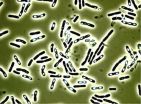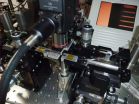(Press-News.org) Large amount of fat in neck muscles predicts chronic pain, disability and PTSD
Will enable earlier treatment for whiplash victims
Fat indicates atrophy, shows the chronic pain is not psychological
Whiplash affects more than 4 million Americans annually
CHICAGO --- While most people should expect to fully recover from whiplash injuries within the first few months, about 25 percent have long-term pain and disability that lasts many months or years.
Using special MRI imaging, Northwestern Medicine scientists have identified, within the first one and two weeks of the injury, which patients will go on to develop chronic pain, disability and post- traumatic stress disorder (PTSD). This is the earliest these patients have ever been identified, according to the scientists.
The ability to identify these patients so early will enable faster and more specialized treatment, which could be particularly beneficial for the PTSD.
After one to two weeks of the injury, Northwestern scientists found unusual muscular changes in the chronic pain group using a sophisticated MRI that measures the fat/water ratio in the muscles. The imaging revealed large amounts of fat infiltrating the patients' neck muscles, indicating rapid atrophy.
The presence of fat in the muscle does not appear to be related to a person's body size or shape.
"We believe this represents an injury that is more severe than what might be expected from a typical low-speed car crash," said lead investigator James Elliott, assistant professor of physical therapy and human movement sciences at Northwestern University Feinberg school of Medicine. The study was published March 17 in the journal Spine.
"This opens up a new door for research on whiplash," Elliott said. "For a long time whiplash has been treated as a homogenous condition. Our study has shown these patients are not all the same; they have different clinical signs and symptoms."
Whiplash-associated disorders from motor vehicle collisions affect more than 4 million Americans annually, harming their quality of life and costing an estimated $30 billion for medical/rehabilitative care per year.
The finding builds on previous research Elliott did as a post-doctoral fellow at the University of Queensland, Brisbane, Australia. That study, which used standard MRI imaging, also found a large amount of fat in neck muscles of whiplash patients at one and three months post injury. Those patients went on to develop chronic pain and disability.
Not everyone needs a MRI scan after a whiplash injury from a motor vehicle collision. However, these findings help physicians understand water/fat MRI, in tandem with other clinical signs/symptoms can be used to identify who is likely to develop post-traumatic stress disorder. This then could be used to justify the referral of the patient to a psychiatrist or psychologist, Elliott said. PTSD is a disorder caused by experiencing or witnessing a traumatic event.
"These patients have shown to not respond well to traditional rehabilitation such as physical therapy," Elliott said. "It appears that they may require a more concerted effort for pain management from their physician and help from a psychologist." Emerging, yet preliminary evidence suggests this to be a reasonable strategy.
The findings may indicate the importance of changing standard imaging protocols to identify these individuals early and start accelerated treatment. Routine imaging does not reveal this fat infiltration in individuals with whiplash injuries.
A small preliminary study previously done by Elliott and Northwestern colleagues shows whiplash victims with chronic pain also have a high level of muscle fat in their lower legs, indicating muscle atrophy.
Elliott hypothesizes these patients may have partially damaged their spinal cord. They reported feeling fatigued and clumsy when walking and weakness in their legs, with difficulty pushing hard on the gas pedal of a car or standing on their tiptoes.
"We haven't found an effective treatment for these folks with chronic whiplash, and I think it's because we haven't really figured out what's wrong with them," Elliott said.
The finding helps to demystify the condition and let individuals know their chronic pain is not all in their heads. A basic exam will not consistently show a fracture, herniated disc or ligament tear.
"If you're a whiplash patient with ongoing chronic pain, but no objective imaging finds anything wrong, people are frequently informed that nothing is wrong with them," Elliott said. "It's been a huge problem."
"That fat appears to be a response to an injury," Elliott said. "What has actually been injured remains for us to find out. But now we know to look more deeply into the problem."
INFORMATION:
Other Northwestern authors include Dr. D. Mark Courtney, Alfred Rademaker, Daniel Pinto and Todd B. Parrish.
The study was funded by the National Center for Research Resources and the National Center for Advancing Translational Sciences of the National Institutes of Health through grants KL2 RR025740 and KL2TR000107.
NORTHWESTERN NEWS: http://www.northwestern.edu/newscenter/
EAST LANSING, Mich. --- America's welfare state is quietly evolving from needs-based to an employment-based safety net that rewards working families and fuels dreams of a better life, indicates a new study led by a Michigan State University scholar.
The major reason: the little-known Earned Income Tax Credit, a $65 billion federal tax-relief program for poor, working families. The program has been expanded dramatically during the past 25 years, while cash welfare has been sharply curtailed.
Reporting in the April issue of the American Sociological Review, Jennifer Sykes ...
ENVIRONMENT - Invertebrates' role in bioaccumulation ...
By studying fish and invertebrates in a creek with known mercury contamination, researchers are gaining a better understanding of the relationship between the toxin in the stream and bioaccumulation in organisms. While mercury concentrations in East Fork Poplar Creek in Oak Ridge, Tenn., have decreased significantly over the last 30 years, levels in tissue from fish have remained the same or increased. To understand why, a team led by Monica Poteat of Oak Ridge National Laboratory is examining the intricacies of ...
WASHINGTON, DC, April 1, 2015 -- America's welfare state is quietly evolving from needs-based to an employment-based safety net that rewards working families and fuels dreams of a better life, indicates a new study led by a Michigan State University (MSU) scholar.
The major reason: the little-known Earned Income Tax Credit (EITC), a $65 billion federal tax-relief program for poor, working families. The program has been expanded dramatically during the past 25 years, while cash welfare has been sharply curtailed.
Reporting in the April issue of the American Sociological ...
WASHINGTON, March 30, 2015 -- Last year, Reactions shook up the comedy world with a video featuring nothing but chemistry jokes. After overwhelming public acclaim, we're back for this April Fools' Day with round two, featuring a number of fan submissions. If you're looking for a laugh, or maybe a groan or two, check out the video here: https://youtu.be/QbxBsD_tDQw.
Subscribe to the series at http://bit.ly/ACSReactions, and follow us on Twitter @ACSreactions to be the first to see our latest videos.
INFORMATION:
The American Chemical Society is a nonprofit organization ...
Irvine, Calif., April 1, 2015 -- A pouchlike structure inside the heart's left atrial chamber in some people may explain strokes that otherwise lack an identifiable cause, according to UC Irvine School of Medicine researchers.
Dr. Mark Fisher, a professor of neurology and pathology & laboratory medicine, and colleagues evaluated 75 stroke patients at UC Irvine Medical Center to learn whether this left atrial septal pouch could be a potent source of stroke-causing blood clots.
Of the 23 patients who had experienced a stroke of undetermined origin (a "cryptogenic" stroke), ...
Jena (Germany) The "Villa trans lacum" at the eastern shore of the Laacher See (lake) in the volcanic part of the Eifel - a rural landscape in Germany - was a highly dangerous place. In the 19th century the Jesuit order bought the abbey Maria Laach and built a villa at the shore of the lake. This is where the friars congregated to pray far away from everyday life. But numerous Jesuits paid with their lives for the religious beliefs in the villa. Between 1864 and 1888 17 of them died in the building - literally in their sleep.
"The monks possibly died of carbon dioxide ...
This news release is available in German.
The Bacillus cereus bacteria is one of the potential causes of food poisoning. Indeed, a recent study in Analytical and Bioanalytical Chemistry shows that this versatile pathogen produces 19 different variants of a poison that causes nausea and vomiting in human beings. This variety could explain why some cases are relatively benign and others can result in death.
Across Europe, the number of food poisoning cases caused by the Bacillus species is on the rise. While unpleasant, infections resulting from B. cereus are usually ...
Our opponents always seem to be one step ahead. Although pest controllers now have numerous chemical preparations available, allowing them to take action against unwanted insects, the species targeted are developing a resistance against the different active substances at a rapid pace. Often a single change in the organisms' genetic material is enough to do this. This means that scientists know more than 500 pests all over the world currently able to resist a total of 300 different insecticides. Many disease-transmitting mosquitoes defy any attempts to control them just ...
The core circuits of quantum teleportation, which generate and detect quantum entanglement, have been successfully integrated into a photonic chip by an international team of scientists from the universities of Bristol, Tokyo, Southampton and NTT Device Technology Laboratories. These results pave the way to developing ultra-high-speed quantum computers and strengthening the security of communication.
Qubits (quantum bits) are sensitive quantum versions of today's computer 0's and 1's (bits) and are the foundation of quantum computers. Photons are particles of light and ...
Penicillin has nearly eradicated rheumatic heart disease (RHD) in the United States. But 15 million people still suffer with the disease worldwide, and 1.4 million die each year, according to World Heart Federation.
Access to penicillin can prevent deaths from RHD. Researchers from Case Western Reserve University, Makerere University and the Uganda Heart Institute at Mulago Hospital, a national referral hospital in Kampala, collaborated to learn about those obstacles to receive the medication and find ways to overcome them.
The researchers heard from some Ugandans ...





